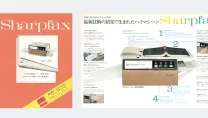Creating a Multifunction Printer (MFP) for the office that anybody can use, is packed with features, and improves productivity is no easy task. Creating all of these in one environmentally conscious package is even harder. We look at how Sharp achieves this.
Sharp cares about creating devices that are practical and innovative. Deeply engrained in our company culture is a respect for the environment; Sharp was the first manufacturer to receive the EU Ecolabel for a TV, and thanks to their energy-saving characteristics, nearly all Sharp Multifunctional Printers carry the respected Energy Star label.
In a recent interview with a number of key design personnel from the Sharp Office Solutions Business Unit in Japan, we discovered how Sharp is 'Going Green Everywhere' and why the MX-6070N/5070N is exactly what your office needs.
1. Motion sensor
In order to stop your multifunctional printer consuming power as it sits waiting for you operate it, the Sharp MFP goes into sleep mode. When you next approach the device, the built-in motion sensor alerts the MFP and wakes it up, so it's ready for you to use the moment you need it.
"A sensor detects when someone approaches the MFP and wakes it from sleep mode. That person has to wait less time to use the MFP," said Yuichiro Takesue (product planning).
2. Reduced warm-up time for scanning...
When copying and scanning, MFPs require time to warm up as the mechanical parts used or necessary for those operations need to reach a certain temperature to function correctly. However, those times have been reduced significantly.
"It now takes only one second to use the scanning function," said Kazushi Yamaneki (software development).
3. ...and for copying
Sharp has aimed to cut the warm up time for copying in half - and succeeded. Sharp engineers went back to the drawing board and redesigned the mechanical parts that make up the printing mechanism.
The process involves a heated belt (called the fusing belt) that applies pressure to paper with toner on it, which then melts the toner to the paper.
"To be able to quickly heat up the belt, we developed the quick-heating belt fusing system," said Kosuke Namisaki (copy fusing technology).
The newly-designed 'quick-heating' belt fusing system uses a roller created using a new material. This new material allows them to make the walls of the roller 80% thinner, thus making it more effective at conducting heat.
Osamu Wada (toner development) said, "we were able to cut warm-up time in half, from 30 to 15 seconds. By the time you finish placing the original document in the MFP and inputting the number of copies, warm-up time is over."
4. Improved toner
As part of making the warm-up time quicker, Sharp developed a toner that can fuse at a lower temperature. However, developing a toner that melts at a lower temperature has its problems when you consider the environmental temperatures of different places around the world, such as tropical regions.
The result is a heat-resistant toner that’s able to melt when necessary.
5. Recyclable toner cartridges
How often do you toss your old, empty toner cartridges in the bin once it’s empty? Probably more than you should. Sharp’s toner cartridges can be collected and recycled.
Moreover, some of these toner cartridges still have toner in them – sometimes more than half full…
6. Auto-ejecting toner
Imagine running out of toner halfway through a printing job. Many people fear it. Instead of waiting for the toner cartridge to be completely empty, they remove the old cartridge, lock in a new one, and continue printing. This is obviously a waste of toner and a waste of money.
"To solve this problem, the cartridges on Sharp's new MFPs automatically pop out when the toner is all gone," said Takeshi Okuda (toner cartridge development). And not before.
7. Printer noise! What printer noise?
Remember the last time you used a printer, you probably remember the clunking sound of paper being drawn out of the paper tray, through the rollers, and out the other side covered in fresh ink. This noise can be disruptive to the people in the working environment.
"Sounds in the 2,000–4,000 Hz range are irritating to humans. MFPs have many moving parts and therefore emit many sounds. We looked for high sounds that differ from their surroundings and worked with people in a number of other Sharp divisions to successfully reduce by 43% the sounds generated by moving parts," said Hiroki Kanemitsu (noise-reduction technology).
Not only that, but by having the different mechanical parts of the MFP start at different times, "their starting sounds don't overlap, the MFP's sounds are less bothersome," said Takahiro Kawakami (motion sensor control circuits).
As you can see, designing for the office and the environment can go hand in hand. To discover more insights from the Sharp Office Solutions Business Unit check out the full ‘Going Green Everywhere’ interview.

Pictured from left to right: Yuhichiroh Takesue, Kazushi Yamaneki, Takeshi Okuda, Takahiro Kawakami, Hiroki Kanemitsu, Kousuke Namisaki, Osamu Wada





